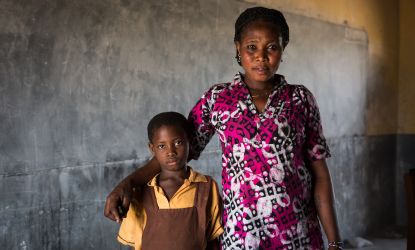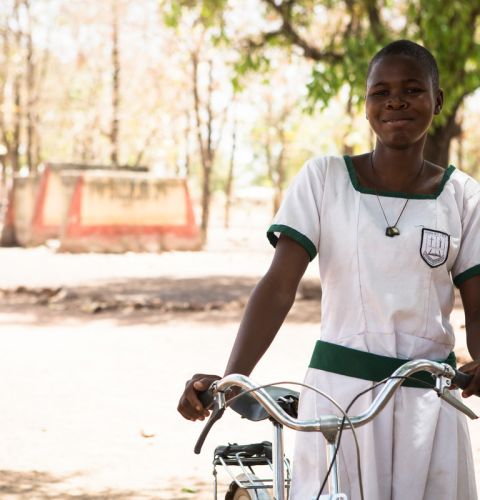Child marriage robs girls of their childhoods, education, health, and freedom.
Learn about the causes and effects of child marriage and what ActionAid does to end it.
Why does ActionAid work to end child marriage?
More than 250 million women alive today were married before their 15th birthday, many against their will and often to much older men.
Girls are often extremely vulnerable to violence when married at a young age. They are also at risk of early childbirth, and sexually transmitted diseases including HIV. Often girls have to cut their education short and as a result, continue to be held back and remain living in poverty.
Hundreds of millions of girls remain at risk especially in sub-Saharan Africa and South Asia
That's why ActionAid is working to end child marriage. We are bringing perpetrators to justice, educating communities on the negative effects of child marriage, so all girls can have the childhood they deserve
What does ActionAid do to help end child marriage?
ActionAid works to fight child marriage in 17 countries across South Asia and sub-Saharan Africa.
Our local staff tackles child marriage on many fronts.
- ActionAid brings perpetrators to justice. We support community-led anti-violence teams (COMBAT) that confront the perpetrators of child marriage directly, either face to face or through formal letters, and work to ensure girls at risk are returned to their families. If captors do not co-operate, the teams work with the authorities to bring them to justice.
- We work to change minds and behaviours in local communities. ActionAid trains and supports local networks of women and men to reach out to their neighbours, families, officials and village leaders to highlight the negative effects of early child marriage and pregnancy, and how keeping girls in school can benefit the whole community.
- We campaign at a regional, national and international level to influence policies and legislation to end violence against girls.
- ActionAid trains female teachers to run girls’ clubs in schools and communities, to empower girls to understand and embrace their rights, including saying no to child marriage. The women are role models to the girls, showing them that finishing their education is possible.
Help girls that are forced to marry
What are the causes of child marriage?
Child marriage happens for different reasons depending on the country. In sub-Saharan Africa and South Asia – where the practice is most widespread – the key drivers are gender inequality and poverty.
-
Gender inequality: Deep-rooted patriarchal beliefs, the low value placed on girls, and the desire to control women, especially girls' sexuality, underpin child marriage. In poorer communities with limited opportunities for education and work, it may seem like alternatives are limited. Even if opportunities are available, social norms that value boys over girls mean parents might not think it worthwhile investing in their daughter’s education.
-
Poverty: For poor families with many children, marrying their daughter off early can mean one less mouth to feed. In addition, there is also a financial aspect due to dowry and bride price traditions.
What are the effects of child marriage?
Child marriage is a violation of girls’ rights and denies them their childhood, the chance to go to school, to be independent and to choose their own future.
- Risk of violence: Marrying girls when young creates huge power imbalances in the relationship. Domestic violence by an intimate partner is more prevalent and more severe amongst girls who marry as children, than amongst women who provide informed consent to marry4. For many girls, child marriage subjects them to rape and abuse for the rest of their lives. Isolated from friends and family they have limited means to get support or share what they are going through.
- Impact on health and life: Young girls are not in a position to influence decisions over safe sex and family planning, which puts them at high risk of sexually transmitted diseases including HIV, and of giving birth before their bodies are ready. Early childbearing puts girls’ lives at risk, and increases the chance of stillbirth, infant mortality, and disabling complications for the mother such as obstetric fistula.
- Education: Girls who are forced to marry young usually drop out of school and cut their education short. This means they lose the chance to learn the knowledge and skills they need to secure a good job and provide for themselves and their families. They also lose the opportunity to be empowered, make friends, and develop social networks and confidence that will help them stand up for their own interests. As a result, millions of girls continue to be held back and remain living in poverty.

Sanatu was abducted when she was 15
Sanatu, 34, from Ghana, was abducted by an older man when she was a teenager. "A man saw me and was interested in me," she describes. "He sent three men. They came and carried me away."
Almost 20 years later she is still married.
Since the moment they brought me - from the time they brought me up until now - I have never been happy in the marriage. They call me his wife but we have nothing in common. I wish I was a child and I could go back to school."
Sanatu has to work very hard on the farm to provide for her family because her husband doesn’t support her. She has a young daughter Sabila and worries that she might be abducted too: “Because I’ve been abducted, I always worry that it will happen to my daughters as well."
ActionAid is working in Sanatu’s village to raise awareness of the problems of child marriage and tackle marriage by abduction.
Sanatu, 34, fears that her daughter Sabila may be abducted and forced into child marriage, Ghana
Ruth McDowall/ActionAid
Footnotes
- 1World Health Organisation (2016), 'Violence against women, intimate partner and sexual violence against women'
- 2UNICEF (2015): 'A profile of child marriage in Africa'
- 3The Lancet (2015), 'Prevention of violence against women and girls: what does the evidence say?'
- 4https://insights.careinternational.org.uk/media/k2/attachments/CARE_Child-marriage-in-emergencies_2015.pdf
Page updated 14 February 2025
